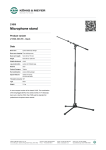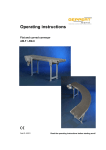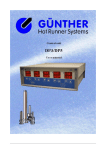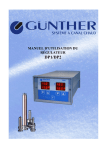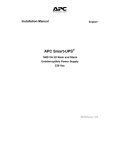Download Operating instructions - Geppert
Transcript
â FÖRDERSYSTEME - CONVEYING SYSTEMS - SYSTÈMES CONVOYEURS Operating manual for the models EM-F EM-Z EM-C EM-R-W Must be read before initial use !!! EM-K-W GEPPERT-Band GmbH Karl-Heinz-Beckurts-Str. 7 D-52428 Jülich Also applies to: EM-R EM-K EM-Z-W EM-S Phone: Fax: +49 2461 93767 0 +49 2461 93767 30 Email: Website: [email protected] www.geppert-band.de â EM-F operating instructions FÖRDERSYSTEME - CONVEYING SYSTEMS - SYSTÈMES CONVOYEURS Table of contents: 1 2 Foreword .......................................................................................................................................... 4 Safety when handling our belt conveyors ........................................................................................ 4 2.1 Safety equipment on our belt conveyors .................................................................................. 4 2.2 General instructions on the proper operation of belt conveyors ............................................... 4 2.3 Obligations of the company operating the belt conveyor .......................................................... 5 2.4 Safety symbols .......................................................................................................................... 5 3 Dimensions and Data ....................................................................................................................... 6 3.1 Belt conveyor frame .................................................................................................................. 6 3.2 Plastic module chains ............................................................................................................... 9 3.3 Motors ..................................................................................................................................... 10 3.3.1 Geared motor type SN3F:................................................................................................ 10 3.3.2 Geared motor type SN9F:................................................................................................ 11 3.3.3 Geared motor type SN8F:................................................................................................ 12 3.4 Electrical devices .................................................................................................................... 13 3.4.1 Frequency converter ........................................................................................................ 13 3.4.2 Protective motor switch .................................................................................................... 14 3.4.3 Emergency stop switch .................................................................................................... 15 4 Adjustments .................................................................................................................................... 16 4.1 Drive units ............................................................................................................................... 16 4.1.1 Lateral drive unit .............................................................................................................. 16 4.2 Adjusting the Conveyor Chain ................................................................................................ 18 4.2.1 Adjust the length of the conveyor chain ........................................................................... 18 4.2.2 Direction of movement of the conveyor chain ................................................................. 19 4.3 Support .................................................................................................................................... 20 4.3.1 Protection against tilting of flat belt conveyors ................................................................ 20 4.3.2 Two-legged aluminium support........................................................................................ 21 4.3.3 Short two-legged aluminium support ............................................................................... 22 4.3.4 Two-legged steel support ................................................................................................ 22 4.3.5 Short two-legged steel support ........................................................................................ 23 4.3.6 Short steel support with lateral retainer ........................................................................... 23 4.3.7 Two-legged stainless steel support ................................................................................. 23 4.3.8 Single-legged support made of steel with aluminium base plate .................................... 24 4.3.9 H single-legged support made of steel ............................................................................ 24 4.3.10 H single-legged support made of steel, movable on castors........................................... 25 4.3.11 H single-legged support made of stainless steel ............................................................. 25 4.3.12 H single-legged support made of stainless steel, movable on castors............................ 25 4.4 Flexible belt conveyors ........................................................................................................... 26 5 Spare parts ..................................................................................................................................... 27 as of June 2014 Page 2 of 27 â EM-F operating instructions FÖRDERSYSTEME - CONVEYING SYSTEMS - SYSTÈMES CONVOYEURS List of illustrations: Figure 3-1: Figure 3-2: Figure 3-3: Figure 3-4: Figure 3-5: Figure 3-6: Figure 3-7: Figure 3-8: Figure 3-9: Figure 3-10: Figure 3-11: Figure 3-12: Figure 3-13: Figure 4-1: Figure 4-2: Figure 4-3: Figure 4-4: Figure 4-5: Figure 4-6: Figure 4-7: Figure 4-8: Figure 4-9: Figure 4-10: Figure 4-11: Figure 4-12: Figure 4-13: Figure 4-14: Figure 4-15: Figure 4-16: Figure 4-17: EM-F frame dimensions ..................................................................................................... 6 EM-C frame dimensions .................................................................................................... 6 EM-R-W frame dimensions ................................................................................................ 7 EM-K-W frame dimensions ................................................................................................ 7 EM-Z frame dimensions ..................................................................................................... 8 Table of the plastic module chains .................................................................................... 9 Frequency converter ........................................................................................................ 13 Frequency converter connection to the motor ................................................................. 13 Protective motor switch .................................................................................................... 14 Protective motor switch connection to the motor ............................................................. 14 Emergency stop switch .................................................................................................... 15 Emergency stop switch connected to 230V 50Hz ........................................................... 15 Emergency stop switch connected to 380V 50Hz ........................................................... 15 Dismantling the engine at the side ................................................................................... 16 Adjusting the play of the coupling .................................................................................... 16 Rotation of the motor ....................................................................................................... 17 Opening and closing the conveyor chain ......................................................................... 18 Direction of movement of the conveyor chain.................................................................. 19 Maximum weight at the end of the belt with mobile supports .......................................... 20 Two-legged support made of aluminium, height adjustment ........................................... 21 Two-legged support made of aluminium, inclination adjustment ..................................... 21 Two-legged steel support, height adjustment .................................................................. 22 Two-legged steel support, inclination adjustment ............................................................ 22 Short steel support with lateral retainer, height adjustment............................................. 23 Single-legged support made of steel with aluminium base plate, height adjustment ...... 24 Single-legged support made of steel with aluminium base plate, inclination adjustment 24 H single-legged support made of steel, movable, brake ................................................. 25 Possible angles of bend ................................................................................................... 26 Setting the angle of bend ................................................................................................. 26 Adjusting the angle of the upper bend ............................................................................. 27 as of June 2014 Page 3 of 27 â EM-F operating instructions FÖRDERSYSTEME - CONVEYING SYSTEMS - SYSTÈMES CONVOYEURS 1 Foreword Our belt conveyors are intended for in-plant use; they are not suitable for wet rooms or operating areas which are at risk of explosion. Special designs suitable for such areas, however, can be made available after consultation and confirmation. As the only maintenance measure required for the belt conveyors we recommend to occasionally check the proper running of the belt. To adjust the running of the belt, we urgently advise you to comply with the instructions given in this operating manual. 2 Safety when handling our belt conveyors All of our standard belt conveyors were designed with a particular focus on safety. Especially when working on the belt conveyors, unnecessary risks should be avoided. For this reason we have deliberately designed many components such that the risk of injury for the operating personnel operating our belt conveyors is minimised. 2.1 Safety equipment on our belt conveyors One of the most frequent types of accident on belt conveyors is injuries to parts of the body which are drawn in between the circulating belt and the rotating rollers. In order to make it impossible for such accidents to occur or to reduce the risk as much as possible, all GEPPERT belt conveyors are fitted with a gap protection at all points where the belt runs onto a cylinder or roller. This gap protection is designed in such a way that during adjustment work it is automatically positioned in correct relation to the roller. To prevent damage to electrical equipment and minimise the risk of an electric shock, all of the parts of our belt conveyors are earthed. All belt conveyors are fitted with a safety switch as standard, which will automatically switch off the device if it is overloaded or overheated. In addition, all devices have an emergency stop switch to turn off the belt conveyor if there is imminent danger present. See also section 3.4. If a belt conveyor is ordered without a safety switch or emergency stop switch, the operator must ensure the correct connection of the device and the possibility of bringing it to a standstill in the case of danger. 2.2 General instructions on the proper operation of belt conveyors All mechanical installation work may only be performed by industrial mechanics (industrial fitters) or individuals who have received corresponding comparable training or instruction. All work carried out on the electrical equipment may only be performed by trained electricians or individuals who have undergone comparable training. The operators and anyone working on a belt conveyor must wear appropriate protective clothing. This includes in particular safety shoes for protecting against falling objects, as well as tight-fitting clothes and hairnets for individuals with long hair to minimise the risk of their hair being drawn into the device. The correct functioning of the emergency stop equipment should be checked every day. This also includes a check of the protection against accidental restart after a drop in voltage. After a drop in voltage, the device must not be able to start up again of its own accord. It may only start after a switch has been activated. If technically possible and provided for, the working height should be set to a level which is ergonomically meaningful. Touching the belt while it is running, as well as the transport of individuals on the conveyor, is not permitted. as of June 2014 Page 4 of 27 â EM-F operating instructions FÖRDERSYSTEME - CONVEYING SYSTEMS - SYSTÈMES CONVOYEURS In an emergency, the belt conveyor can be moved backwards after being switched off by hand by pulling on the belt. 2.3 Obligations of the company operating the belt conveyor The company operating a belt conveyor must ensure that the important preconditions for the safe functioning of the device are fulfilled. For this, the following must be complied with: - 2.4 The workplace of people working on the belt must be sufficiently illuminated. The devices may only be used within buildings. Compliance with the approved weights must be ensured. Here, attention must also be paid to the danger of belt conveyors on supports with castors tipping over. Any retrofitted parts must not result in the operator being placed at risk. Safety symbols Some of our standard belt conveyors may be furnished with special safety test symbols. Upon request, these will also be attached to the device. However, a specific adaptation is often required due to the individual use of the belt conveyor. This can be carried out by us as the manufacturer or by the client himself. In both cases this may result in the safety test symbol no longer being valid. as of June 2014 Page 5 of 27 â EM-F operating instructions FÖRDERSYSTEME - CONVEYING SYSTEMS - SYSTÈMES CONVOYEURS 3 Dimensions and Data 3.1 Belt conveyor frame The most important dimensions of the EM-F / EM-C / EM-R-W / EM-K-W / EM-Z belt conveyors are shown in the following illustrations: Figure 3-1: EM-F frame dimensions Figure 3-2: EM-C frame dimensions as of June 2014 Page 6 of 27 â EM-F operating instructions FÖRDERSYSTEME - CONVEYING SYSTEMS - SYSTÈMES CONVOYEURS Figure 3-3: Figure 3-4: as of June 2014 EM-R-W frame dimensions EM-K-W frame dimensions Page 7 of 27 â EM-F operating instructions FÖRDERSYSTEME - CONVEYING SYSTEMS - SYSTÈMES CONVOYEURS Figure 3-5: EM-Z frame dimensions The frame dimensions of the EM-K, EM-R and the EM-S correspond to those of the EM-Z. The frame dimensions of the EM-Z-W correspond to those of the EM-K-W. as of June 2014 Page 8 of 27 â EM-F operating instructions FÖRDERSYSTEME - CONVEYING SYSTEMS - SYSTÈMES CONVOYEURS 3.2 Plastic module chains The technical data of the plastic module chains which are used most frequently by us is shown in the following overview. Chain types Belt widths QNB ASB S-MPB 153 mm 147 mm 228 mm 305 mm 301 mm 304 mm 457 mm 454 mm 380 mm 610 mm 607 mm 456 mm 532 mm 608 mm Bolts PA6.6 PA6.6 PA6.6 Division 25.4 mm 25.4 mm 25.4 mm Overall thickness 8,8 mm 12 mm 8,8 mm Colour blue blue white Material supporting side PP POM-D PP smooth, closed smooth, open 43% smooth, closed Antistatic Non Non Non Resistant to oil and grease Yes Yes Yes Yes +1°C to +104°C Yes - 40°C to + 90°C Yes +1°C to +104°C Surface of the supporting side FDA approval Temperature range Figure 3-6: as of June 2014 Table of the plastic module chains Page 9 of 27 â EM-F operating instructions FÖRDERSYSTEME - CONVEYING SYSTEMS - SYSTÈMES CONVOYEURS 3.3 Motors Standard three-phase AC motors with worm gears with the protection rating IP 54 are used as standard in our belt conveyors. The dimensions and data of the various standard motors are listed below. Special motors are available on request. The adjustment and maintenance of the drive chains or couplings are described in section 4. 3.3.1 c1 Geared motor type SN3F: Mounting dimensions ød1 ød2 ød3 ød4 j øs1 10 120 100 80 52 3 M6 g g1 k Outline dimensions k1 o1 q1 o q 125 108 288,5 187 41,5 33 99 35 y z ød 30 74 14 Shaft dimensions l1 l2 l t 30,0 20 Gearbox data Motor data 180 Watt, 1400 rpm, weight 6,1Kg, 0,7Amps with 380V, IP54 Gearbox ratio 7:1 10 : 1 15 : 1 20 : 1 30 : 1 Gearbox speed 200 rpm 140 rpm 93 rpm 70 rpm 47 rpm Effective torque 6,7 Nm 10 Nm 12 Nm 12 Nm 14 Nm max. permissible torque 12 Nm 12 Nm 13 Nm 13 Nm 13 Nm as of June 2014 5 16,0 u 5 56 : 1 25 rpm 17 Nm 10 Nm Page 10 of 27 â EM-F operating instructions FÖRDERSYSTEME - CONVEYING SYSTEMS - SYSTÈMES CONVOYEURS 3.3.2 Geared motor type SN9F: c1 Mounting dimensions ød1 ød2 ød3 ød4 j øs1 8 120 100 80 65 3 7 g g1 k Outline dimensions k1 o1 q1 o q 140 114 327 207 60 40 102 40 y z ød i 25 121 16 1 Shaft dimensions l1 l2 l t 35 Gearbox data Motor data 370 Watt, 1400 rpm, weight 9,2Kg, 1,2Amps with 380V, IP54 Gearbox ratio 7:1 10 : 1 15 : 1 20 : 1 30 : 1 Gearbox speed 207 rpm 140 rpm 93 rpm 70 rpm 47 rpm Effective torque 14 Nm 20 Nm 27 Nm 29 Nm 36 Nm max. permissible torque 30 Nm 30 Nm 28 Nm 29 Nm 30 Nm as of June 2014 25 5 18 u 5 50 : 1 28 rpm 48 Nm 27 Nm Page 11 of 27 â EM-F operating instructions FÖRDERSYSTEME - CONVEYING SYSTEMS - SYSTÈMES CONVOYEURS 3.3.3 c1 Geared motor type SN8F: Mounting dimensions ød1 ød2 ød3 ød4 j øs1 10 120 100 80 80 3 7 g g1 k Outline dimensions k1 o1 q1 o q 140 114 334 207 67 53 124 46 y z ød i 25 141 20 1 Shaft dimensions l1 l2 l t 50 Gearbox data Motor data 550 Watt, 1400 rpm, weight 10,7Kg, 1,6Amps with 380V, IP54 Gearbox ratio 7:1 10 : 1 15 : 1 21 : 1 30 : 1 Gearbox speed 210 rpm 145 rpm 93 rpm 67 rpm 47 rpm Effective torque 21 Nm 28 Nm 41 Nm 50 Nm 56 Nm max. permissible torque 56 Nm 57 Nm 60 Nm 57 Nm 59 Nm as of June 2014 30 10 22,5 u 6 50 : 1 28 rpm 60 Nm 51 Nm Page 12 of 27 â EM-F operating instructions FÖRDERSYSTEME - CONVEYING SYSTEMS - SYSTÈMES CONVOYEURS 3.4 Electrical devices All of our electrical devices may only come into contact with dust and liquids as specified by the protection rating applicable to them. Any contact of the electrical devices with liquids or dust that goes beyond this must be avoided. 3.4.1 Frequency converter All of our belt conveyors which are to have adjustable belt speeds are equipped with a frequency converter as standard which controls a robust three-phase AC motor. For all motors up to 250 watts performance the GB-FU 250 device is used. For motors from 250 to 370 watts the GB-FU 370 device is used. Motors which have more power than 370 watts are fitted with a frequency converter that is specifically adapted to them. Figure 3-7: Frequency converter All frequency converters are digital devices which can be individually programmed. Each frequency converter also includes the function of protecting the motor against overload. Thus the destruction of the motor by a mechanically jammed belt conveyor is almost impossible. In this case the frequency converter turns the current off. The frequency converters are connected to 230V 50Hz AC. Separate operating instructions exist for these devices and are enclosed with every delivery. Any change to the programming may only be carried out by trained personnel and after consultation with Geppert Band. Figure 3-8: Frequency converter connection to the motor Furthermore, the frequency converter is equipped with an emergency stop switch in the form of a mushroom-type button to stop the belt conveyor quickly in the case of danger. After the voltage has dropped, the belt conveyor does not restart automatically, but a separate start button has to be operated. as of June 2014 Page 13 of 27 â EM-F operating instructions FÖRDERSYSTEME - CONVEYING SYSTEMS - SYSTÈMES CONVOYEURS 3.4.2 Protective motor switch All of our belt conveyors which are to have a constant belt speed are equipped with a protective motor switch, which controls a sturdy three-phase AC motor. Figure 3-9: Protective motor switch The protective motor switch has the function of protecting the motor against overload. Thus the destruction of the motor by a mechanically jammed belt conveyor is almost impossible. In this case the protective motor switch turns the current off. Furthermore, the protective motor switch is equipped with an emergency stop switch in the form of a snap-switch, which makes it possible to bring the belt conveyor to a standstill quickly. The protective motor switch is connected to 380V 50Hz three-phase current. Figure 3-10: Protective motor switch connection to the motor as of June 2014 Page 14 of 27 â EM-F operating instructions FÖRDERSYSTEME - CONVEYING SYSTEMS - SYSTÈMES CONVOYEURS 3.4.3 Emergency stop switch In addition, all belt conveyors can be fitted with one or more emergency stop switches in the form of a mushroom-type button. The emergency stop switch is positioned between the source of the current and the belt conveyor in series, so that individually operating any switch will immediately bring the entire belt conveyor to a standstill. Figure 3-11: Figure 3-12: Emergency stop switch connected to 230V 50Hz Figure 3-13: Emergency stop switch connected to 380V 50Hz as of June 2014 Emergency stop switch Page 15 of 27 â EM-F operating instructions FÖRDERSYSTEME - CONVEYING SYSTEMS - SYSTÈMES CONVOYEURS 4 Adjustments During all adjustment work it must be ensured that all of the covers and brackets that have been removed to carry out such work are correctly reattached after the adjustments have been carried out and before the belt is put back into operation. 4.1 4.1.1 Drive units Lateral drive unit If the motor is attached on the side next to the belt conveyor, it must be ensured that the coupling is correctly adjusted. In order to adjust the coupling, it is first necessary, as shown in the adjacent illustration, to remove the motor (A) by loosening the retaining nuts (B). Figure 4-1: Dismantling the engine at the side Then, as shown in the adjacent illustration, the distance between the coupling wheels (C) of the motor (A) and the drive roller (D) shall be approximately 15mm if the housing of the coupling (E) is held between the motor (A) and the flange (F). After the distance has been adjusted, the coupling sleeve (not shown) has to be placed over the wheel of the coupling (C) on the drive roller (D) and the motor reassembled. The retaining nuts (B) then have to be retightened. Figure 4-2: as of June 2014 Adjusting the play of the coupling Page 16 of 27 â EM-F operating instructions FÖRDERSYSTEME - CONVEYING SYSTEMS - SYSTÈMES CONVOYEURS When the motor is attached on the side next to the belt conveyor, the motor can, as shown in the adjacent illustration, be installed by turning in steps of 90° around the flange. Figure 4-3: as of June 2014 Rotation of the motor Page 17 of 27 â EM-F operating instructions FÖRDERSYSTEME - CONVEYING SYSTEMS - SYSTÈMES CONVOYEURS 4.2 4.2.1 Adjusting the Conveyor Chain Adjust the length of the conveyor chain The conveyor chain has already been set at the factory to the required length. If necessary, a readjustment is carried out as follows: 1. Open the conveyor chain (1) at any point by knocking out a bolt (2). 2. Adjust the length of the chain by removing or inserting the required number of modules. 3. Close the conveyor chain (1) again by inserting the last bolt (2). NOTE! The slack of the chain below the drive roller must be at least 20mm. The following applies in general: the longer the conveyor chain, the greater the slack. A readjustment might become necessary due to temperature fluctuations. Figure 4-4: Opening and closing the conveyor chain as of June 2014 Page 18 of 27 â EM-F operating instructions FÖRDERSYSTEME - CONVEYING SYSTEMS - SYSTÈMES CONVOYEURS 4.2.2 Direction of movement of the conveyor chain The conveyor chain has already been mounted at the factory onto the conveyor in the correct direction of travel. After disassembly, it should be remounted as shown in the illustration: Gear wheel Figure 4-5: as of June 2014 Gear wheel Direction of movement of the conveyor chain Page 19 of 27 â EM-F operating instructions FÖRDERSYSTEME - CONVEYING SYSTEMS - SYSTÈMES CONVOYEURS 4.3 Support 4.3.1 Protection against tilting of flat belt conveyors Belt conveyors which are equipped with supports that are intended for bolting to the floor should indeed be secured with such a bolted connection. Some of our supports are equipped with security casters with brakes. As a result, the belt conveyor can easily be used in different locations. However, these supports are less stable than supports without castors. For this reason, when the belts are moved to another location via a ramp or slope, the device must be secured by additional means as it may otherwise tilt over. While the belt conveyor is being operated, it should be ensured that the supports are attached in each case as closely as possible to the end of the belt. For a distance of 400mm between the end of the belt and the middle of the support (projection a), the following diagram shows the maximum permitted weight on the end of the belt conveyor for a known length and width of the belt conveyor. Maximum weight at the end of the belt for EM-F with movable supports Figure 4-6: as of June 2014 Maximum weight at the end of the belt with mobile supports Page 20 of 27 â EM-F operating instructions FÖRDERSYSTEME - CONVEYING SYSTEMS - SYSTÈMES CONVOYEURS 4.3.2 Two-legged aluminium support The height of the two-legged aluminium support can be continuously adjusted. First of all, as shown in the adjacent illustration, the fixing screws (A) of the cross bar (B) have to be released. Then the support insert (C) can be pulled out of or pushed into the external tube of the support. An adjustment range of 200mm is provided as standard. After the adjustment, both fixing screws (A) must be firmly re-tightened. Figure 4-7: adjustment Two-legged support made of aluminium, height Figure 4-8: adjustment Two-legged support made of aluminium, inclination The two-legged aluminium support can also be adjusted continuously in terms of its inclination. First of all, as shown in the adjacent illustration, the fixing screws (A) on the support plate (B) have to be released. Then the support can be swivelled in the guide mechanisms (C) of the support plate (B) from +30° to -30°. In the vertical position, the support locks into the positioning lock (D) and is therefore secured against accidentally folding inwards. The two-legged aluminium support is also available in a version with support plates that have a swivel range from the horizontal position to the vertical position. as of June 2014 Page 21 of 27 â EM-F operating instructions FÖRDERSYSTEME - CONVEYING SYSTEMS - SYSTÈMES CONVOYEURS 4.3.3 Short two-legged aluminium support In a shortened version, the two-legged aluminium support is equipped with fixed castors. Its height can also be adjusted as described under 4.3.2, although the adjustment range is only intended to compensate for uneven floors and is only 50mm. The inclination is adjusted as described under 4.3.2. 4.3.4 Two-legged steel support The height of the two-legged steel support is continuously adjustable. First of all, as shown in the adjacent illustration, the fixing screws (A) of the crossbar (B) have to be released to a small amount. Then the support insert (C) can be pulled out of or pushed into the external tube of the support. An adjustment range of 200mm is provided as standard. After the adjustment, both fixing screws (A) must be firmly retightened. The two-legged steel support can also be continuously adjusted with respect to its inclination. First of all, as shown in the adjacent illustration, the fixing screws (A) on the support plate (B) have to be released. Then the support can be swivelled in the guide mechanisms (C) of the support plate (B) from +30° to -30°. In the vertical position, the support locks into the positioning lock (D) and is therefore secured against accidentally folding inwards. The two-legged steel support is also available in a version with support plates which have a swivel range from the horizontal position to the vertical position. as of June 2014 Figure 4-9: Two-legged steel support, height adjustment Figure 4-10: Two-legged steel support, inclination adjustment Page 22 of 27 â EM-F operating instructions FÖRDERSYSTEME - CONVEYING SYSTEMS - SYSTÈMES CONVOYEURS 4.3.5 Short two-legged steel support The two-legged steel support is equipped in a shortened variation with fixed castors. The height can also be adjusted, as described under 4.3.4, although the adjustment range is intended only to compensate for uneven floors and is only 50mm. The adjustment of the inclination is carried out as described under 4.3.4. 4.3.6 Short steel support with lateral retainer In order to adjust the height of the short steel support with lateral retainer, it is necessary first of all, as shown in the adjacent illustration, to release the fixing screws (A) on the lateral retainer (B). It is then possible to adjust the short support (C) in the lateral retainer (B). After the adjustment procedure, both fixing screws (A) must be firmly retightened. Figure 4-11: adjustment Short steel support with lateral retainer, height 4.3.7 Two-legged stainless steel support The two-legged stainless steel support offers the same adjustment options as the two-legged steel support. as of June 2014 Page 23 of 27 â EM-F operating instructions FÖRDERSYSTEME - CONVEYING SYSTEMS - SYSTÈMES CONVOYEURS 4.3.8 Single-legged support made of steel with aluminium base plate The single-legged support made of steel with aluminium base plate can be continuously adjusted in terms of its height. As shown in the adjacent illustration, it is first necessary to release the fixing screw (A) on the adjusting collar (B). Here, the belt conveyor must be secured against unintentional lowering. Then the forked pipe (C) can be pulled out or pushed into the support base (D). An adjustment range of 200mm is provided as standard. After the adjustment process, the fixing screw (A) must be firmly retightened. Figure 4-12: Single-legged support made of steel with aluminium base plate, height adjustment The single-legged support made of steel with aluminium base plate can also be adjusted continuously in terms of its inclination. First of all, as shown in the adjacent illustration, the fixing screws (A) on the support plate (B) have to be released. Then the support can be swivelled in the guide mechanisms (C) of the support plate (B) from the horizontal to the vertical position. Figure 4-13: Single-legged support made of steel with aluminium base plate, inclination adjustment 4.3.9 H single-legged support made of steel The H single-legged support made of steel has the same adjustment options as those of the singlelegged support made of steel with an aluminium base plate. as of June 2014 Page 24 of 27 â EM-F operating instructions FÖRDERSYSTEME - CONVEYING SYSTEMS - SYSTÈMES CONVOYEURS 4.3.10 H single-legged support made of steel, movable on castors The H single-legged support made of steel, movable on castors, offers the same adjustment options as the H single-legged support made of steel. In addition, it is equipped with Total Stop safety castors which, as shown in the adjacent illustration, can be secured against unintentional rolling by operating the brake. Figure 4-14: brake H single-legged support made of steel, movable, 4.3.11 H single-legged support made of stainless steel The H single-legged support made of stainless steel offers the same adjustment options as the H single-legged support made of steel 4.3.12 H single-legged support made of stainless steel, movable on castors The H single-legged support made of stainless steel, movable on castors, offers the same adjustment options as the H single-legged supports made of steel, movable on castors. as of June 2014 Page 25 of 27 â EM-F operating instructions FÖRDERSYSTEME - CONVEYING SYSTEMS - SYSTÈMES CONVOYEURS 4.4 Flexible belt conveyors In all of our flexible belt conveyors it is possible to adjust the angle of the bend between 20° and 70° in 5° steps, relative to the horizontal. The setting of angles shallower than 20° cannot be recommended, as this has negative effects on the movement of the chain. Before the angle is changed on any of our flexible belt conveyors, the chain has to be adjusted as described in section 4.2. After every change the chain has to be readjusted as described in section 4.2. Figure 4-15: Possible angles of bend In order to adjust the angle of the bend of the EM-K-W or the lower bend of the EM-Z it is necessary, as shown in the adjacent illustration, to release the fixing screws (A) on the side plate of the bend (B). Then the angle of bend can be changed. After the change of the bend, the fixing screw (A) must be firmly retightened. Figure 4-16: as of June 2014 Setting the angle of bend Page 26 of 27 â EM-F operating instructions FÖRDERSYSTEME - CONVEYING SYSTEMS - SYSTÈMES CONVOYEURS In order to adjust the angle of the upper bend of the EMZ, it is necessary, as shown in the adjacent illustration, to release the fixing screws (A) on the side plate of the bend section (B). Then the angle of bend can be changed. After the change of the bend, the fixing screw (A) must be firmly retightened. Figure 4-17: Adjusting the angle of the upper bend 5 Spare parts All components of the belt conveyor types EM-F, EM-C, EM-R-W, EM-K-W and EM-Z are listed in the following exploded diagrams. If a part of your belt conveyor is not listed, it is a purpose-built special part We maintain a complete record of all special parts manufactured in our production documents. Please contact us directly if you need help with such a part. as of June 2014 Page 27 of 27 6 D 5 4 3 2 1 952 adjusting ring DIN 705-B30 967 905b 913 bearing SS 6204 2RS 959 DIN 6885-A8x7x25 957 D bearing SS 6204 2RS 953 714 clutch wheel clutch sleeve clutch wheel gear drive 905b 967 913 905c 970 967 905b 958 plastic modular belt C 905c 952 bearing SS 6204 2RS 957 905c B C B DIN 6885-A8x7x25 958 960 bearing SS 6204 2RS 952 970 910 905b Gezeichnet A Datum 12.06.2012 Name S. Weiss plastic modular belt, EM-C Kontrolliert pull at the side, right Norm 967 Menge: Ma stab: Material: Allgemeintoleranzen DIN 7168-m 905b Geppert-Band GmbH adjusting ring DIN 705-B30 F rdersysteme [email protected] www.Geppert-Band.de Status 6 5 4 nderungen 3 Datum Z-Nr.: 1 1023a-eng A3 Name 2 1 A 6 5 4 3 2 1 bearing SS 6204 2RS 905b D 952 D 955a DIN 6885-A8x7x25 956 adjusting ring DIN 705-B30 950 913 952 951 905b C C bearing SS 6204 2RS 905b plastic modular belt 954a bearing SS 6204 2RS DIN 6885-A8x7x25 952 956 adjusting ring DIN 705-B30 B B 951 950 905b gear drive bearing SS 6204 2RS clutch wheel A Gezeichnet clutch sleeve Datum 11.05.2012 Name S. Weiss plastic modular belt, EM-F Kontrolliert pull at the side, left Norm clutch wheel Geppert-Band GmbH F rdersysteme [email protected] www.Geppert-Band.de 714 Status 6 Menge: Ma stab: Material: Allgemeintoleranzen DIN 7168-m 953 5 4 nderungen 3 Datum Z-Nr.: 1 1022a-eng A3 Name 2 1 A






























